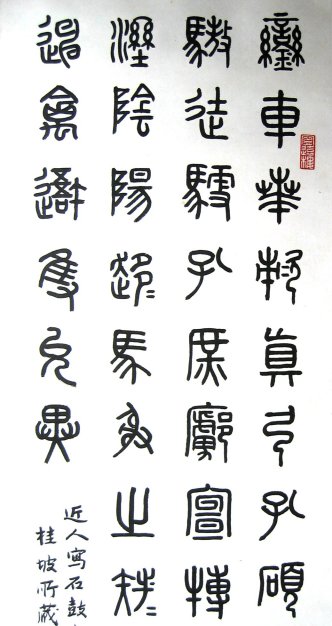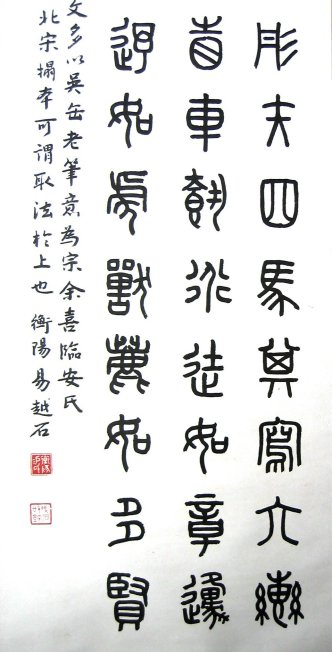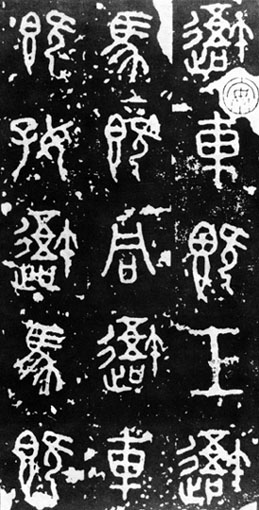






Stone Drum (Shihku) Inscriptions Scroll by Famous Hong Kong Calligrapher Yi Yueshi (1912-2007 )
香港名書法家易越石 (1912 -2007 )《石鼓文》書法立軸
Yi Yueshi (1912-2007 )
Biographical Notes
A native of Hengyang, Hunan. Yi is an expert in seal-character research, who began his studies in Chinese painting, calligraphy, seal carving, and engraving in China in 1920s. Since he settled down in Hong Kong in 1949, he devotes his full time to calligraphy and seal carving. Yi excells in calligraphy, painting and seal carving, and is particularly noted for writing oracle bone script, clerical in the style of the Han dynasty and Stone Drum or Shihku script. Yi is an ardent traveler, who often chooses scenes from his travels as the subject of his work. He has published several books on calligraphy and seal carving including 'Study on Shihku Characters' in 1982 and 'An Historical Outline of Masters in Seal Carving'.
Selected Exhibition Records
Yi Yueshi has held solo exhibition in Hong Kong in 1978 and 1984. Yi has also held numerous solo exhibitions abroad, mainly in Asia. His works were also featured in joint exhibitions including '1956 Joint Exhibition of the works of carvers in Hong Kong and Macao'、'Modern Chinese Painting and Calligraphy from the Taiyilou Collection' (Hong Kong Museum of Art '1991), and 'Joint Exhibition of Yi Yueshi's Paintings and Calligraphy and Jie Jianling's Sculptural Arts' (2001)
易越石 (1912 - 2007)
字慧伯,號培堂,一號士卿,1912年夏歷十月六日生於湖南衡陽迴雁峰下愛蓮亭畔。幼讀《四書》《左傳》。1924年私淑同里曾熙學詩琴書畫。1925年起習金石篆刻。易氏遵奉“ 讀萬卷書,行萬里路”的古訓,注重游歷寫生。1933年至北京,觀賞故宮歷代書畫及石鼓文真蹟。1936年經雲貴入川,游峨眉、青城諸山。1937年,他首度在成都舉辦金石書畫展,書畫大師張大千曾為題耑,由此聲名鵲起。同年游西康(今川西)諸名勝,遇康定道尹、金石篆刻家康同生,師事之。1945年考賞西安碑林,臨摹名碑書法。1946年登華山險峰,亦游西湖寫生。1949年游桂林寫生。易氏游遍大江南北,故其刻印“步行十萬里 ”,當非虛言。同年移居香港,專業從事書法及篆刻創作, 並孜孜不倦教授後輩書藝。
易氏工書畫、篆刻。書法兼擅甲骨、鐘鼎、漢隸及石鼓文等各體。易氏繪畫以山水為主,兼及花鳥人物。其畫作注重形似色彩,發揮氣韻理趣,不脫古人法度,又自具個性。易氏自弱冠始,即臨摹及研究石鼓文。石鼓文又稱獵碣文,易氏既作研究,又作臨摹,兼二者於一身。著有《石鼓文新考》《石鼓文書法與研究》二書,將石鼓文補訂為505字,較清代阮元刻本多出63字,香港著名學者饒宗頤稱其“薈萃古今,折衷至當 ”,又稱其臨本“運筆紓徐沈著,更能存石鼓文之真貌.....堪為后學津逮”,是極其公允的評價。易氏篆刻風格一如其書法,構思嚴密、布局巧妙。在師法多家的基礎上,易越石形成自己的風格,其為名作家金庸所刻之“金庸作品集 ”印,平正端莊,不趨流俗。在當代中國印學名家中,易氏占有一席之地。易氏並著有《歷代印學家概述》一書。
展覽資料
易越石作品曾於多次在長沙、香港、澳門、台北、高雄、台南、泰國曼谷、新加坡、馬來西亞吉隆坡、加拿大溫哥華、澳大利亞坎培拉、墨爾本、雪梨、日本熊本縣、美國洛杉磯、紐約,菲律賓馬尼拉等地舉辦書畫篆刻個人展覽。聯展包括「1958港澳篆刻家作品聯合展覽」 「太乙樓藏中國近代書畫」展 (香港藝術館.1991) 「易越石書畫、解建陵雕塑聯展」(2001)等。
Click at the Images Below to See Other Paintings of this Painter in the Collection
Stone Drum or Shihku Inscriptions
Before the invention of paper and printing, the best way in China to keep outstanding writings and calligraphic works was to carve them on stone. Those cut on drum shaped blocks are called Shihkuwen (stone drum inscriptions); and those cut on steles and tablets are called beimen. The former, being much earlier and rarer, are greatly treasured.
The "Stone Drums" are ten inscribed granite boulders now preserved in the Palace Museum, Beijing, whose inscriptions are believed to be extremely ancient and which have inspired a tremendous amount of research and speculation since the seventh century A.D. The stones average about 80 cm in height and 60 cm in diameter, and probably weigh about a half ton each. The Stone Drums were discovered, about A.D. 600, near Fengxiang, Shaanxi. Their vicissitudes since then are described in written sources of various periods, and there is no doubt that the stones now in the Palace Museum are the same stones as those described in the seventh century. However the taking of rubbings through the ages has damaged the inscriptions severely, and the best material now available for the study of the inscriptions consists of rubbings taken in the Song period.Of an estimated 700 characters in the original inscriptions only 501 remained in the Song and only 272 remain today. The difficulties in interpreting what remains of the inscriptions begin at the lowest level, with the identification of the individual strokes of the characters in a rubbing of a damaged surface, and continue at all higher levels.
Researches of the inscriptions found that the inscriptions were composed in the state of Qin, perhaps in the fifth century B.C. The stone drum inscriptions are located approximately 20 li [ca. 11 km in this period] south of the district [i.e. the district seat of Tianxing]. In shape the stones resemble drums. They are ten in number. [Their inscriptions] record a hunting [expedition] of King Xuan of Zhou, and thus their inscriptions are remains of [the calligraphy of] Shi Zhou [Shi Zhou zhi ji]. In the Zhenguan period [627-649] Su Xu, Attendant of the Board of Civil Service, wrote of them: "Yu [Shinan], Chu [Suiliang], and Ouyang [Xun] all acclaimed their antiquity and excellence. Li Si (ca. 278-8 B.C.) was the presumed author and calligrapher of the many stone inscriptions of the First Emperor of Qin. Shi Zhou was the legendary historian of King Xuan of Zhou (trad. r. 827-782 B.C.).
石鼓文,亦稱獵碣或雍邑刻石,是我國現存最早的刻石文字。無具體年月,唐人韋應物和韓愈的《石鼓歌》都認為是周宣王時期的刻石。宋人歐陽修的《石鼓跋尾》雖設了三個疑點,但還是認為屬周宣王時史籀所作。宋人鄭樵《通志略》則認為《石鼓》系先秦之物,作于惠文王之後,始皇之前。近人羅振玉《石鼓文考釋》和馬敘倫《石鼓文疏記》都認為是秦文公時物,與韋、韓說法出入不大,只相差十七年。據郭沫若考證,《石鼓》作于秦襄公八年,距宣王更近。所不同者,出於宣王時史籀手筆或秦臣手筆罷了。
《石鼓》于唐代初出土於天興三疇原(今陝西省寶雞市鳳翔三疇原),以後被遷入鳳翔孔廟。五代戰亂,石鼓散於民間,至宋代幾經周折,終又收齊,放置於鳳翔學府。宋徽宗素有金石之癖,尤其喜歡《石鼓》,于大觀二年(西元1108年),將其遷到忭京國學,用金符字嵌起來。後因宋金戰爭,複遷《石鼓》于臨安(今杭州),金兵進入汴京後,見到石鼓以為是“奇物”,將其運回燕京(今北京)。此後,石鼓又經歷了數百年的風雨滄桑。抗日戰爭爆發,為防止國寶被日寇掠走,由當時故宮博物院院長馬衡主持,將石鼓遷到江南,抗戰勝利後又運回北京,1956年在北京故宮展出。清乾隆五十五年(1790年),清高宗為更好地保護原鼓,曾令人仿刻了十鼓,放置於辟雍(大學)。現仿鼓在北京國子監。其形狀與刻字部位和原石鼓有不少差別。
石鼓共十隻,高二尺,直徑一尺多,形象鼓而上細下粗頂微圓(實為碣狀),因銘文中多言漁獵之事,故又稱它為《獵碣》。以籀文分刻十首為一組的四言詩。目前其字已多有磨滅,其第九鼓已無一存字。其書傳為史籀手筆,體態堂皇大度、圓活奔放,氣質雄渾,剛柔相濟,古茂遒樸而有逸氣。橫平豎直,嚴謹而工整,善用中鋒,筆劃粗細基本一致,有的結體對稱平正,有的字則參差錯落,近於小篆而又沒有小篆的拘謹。在章法佈局上,雖字字獨立,但又注意到了上下左右之間的偃仰向背關係、其筆力之強勁在石刻中極為突出,在古文字書法中,是堪稱別具奇彩和獨具風神的。康有為稱其“如金鈿委地,芝草團雲,不煩整我,自有奇采。”其書體為大篆向小篆過渡時期的文字,學《石鼓文》可上追大篆,下學小篆,百無一失。後世學篆者皆奉為正宗,無不臨習。楊沂孫、吳大澄、吳昌碩、王福庵等皆得力於此。
石鼓文的拓本,唐代就有,但沒有流傳下來。宋安國所藏石鼓宋拓本,被民國秦文錦售給日本東京河井荃廬氏。此外,社會上所流傳的早期拓本有北宋的《先鋒》、《中權》、《後勁》三種,其中天一閣藏北宋拓存四百二十二字本為最。然原拓己失,現只能見到郭沫若30年代在日本收集的此三種拓本的照片。安國所藏的宋拓本《先鋒》本,舊商務印書館、文物出版社有影印本,收在郭沫若所著《石鼓文研究》一書中。上海藝苑真賞社、日本鳹 堂有《中權》本影印本。中華書局、日本二玄社出版的《書跡名品叢刊》中,有《後勁》本影印本。上海書畫出版社《書法》1984年第三期,也刊有石鼓文的宋拓影印本。石鼓為中國第一古物,亦為書家第一法則,具有很高的文史價值和藝術收藏價值。
石鼓文比金文規範、嚴正,但仍在一定程度上保留了金文的特徵,它是從金文向小篆發展的一種過渡性書體。石鼓文是大篆留傳後世,保存比較完整且字數較多的書跡之一, 故此人們一般稱它為大篆。石鼓文雖然線條圓轉流暢,但結體過於工穩平正,線條刻意修飾美化,缺乏大篆自然天成般的結構與章法,卻跟秦泰山刻石、琅琊臺刻石等小篆相差無幾。如果以現在的審美來看,卻是件缺乏天趣、匠氣十足的作品而已。吳昌碩寫它寫了一輩子,雖然加入了非常強烈的個性特徵,但在藝術性方面卻無法脫去石鼓文本身的那股“匠氣”。
 《石鼓文》局部
《石鼓文》局部
Click Here to See Other Hong Kong/Guangdong Paintings